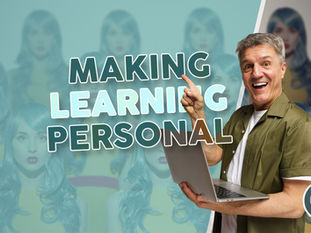
What Makes Learners Lean In?
Have you ever sat through training where your mind wandered within minutes? Maybe you checked emails, maybe you daydreamed about lunch. You were physically in the room, but mentally far away.
Now flip the memory. Think of a time when training genuinely grabbed you. You forgot to check your phone. You scribbled notes. You felt, ‘This is actually useful.’

That difference is not down to flashy slides or clever tech. It’s psychology. Learners lean in when training feels relevant, emotional, and credible. And for digital learning teams, understanding that psychology is the key to transforming engagement.
Why Psychology Matters in Learning Engagement
The human brain is wired for stories and emotion. When something feels personally relevant, it activates the same brain regions as real-life experiences, a process called narrative transportation. In other words, learners aren’t just hearing content, but living it.
This matters because people don’t learn best through logic alone. We learn when information connects to what we care about, when it feels like part of our story. That’s why training that is dry, abstract, or overloaded with jargon gets tuned out.
The Hidden Drivers of Engagement
Based on both psychology and our work at Popcorn, here are three key drivers of learner engagement:
Relevance
Learners ask themselves, “Does this matter to me right now?” If training is too generic, it won’t stick. Tailoring content to real workplace challenges makes it feel valuable, not theoretical.
Emotion
Neuroscience shows that emotion strengthens memory. If a programme makes learners feel inspired, curious, or even challenged, they’re more likely to remember it.
Credibility
Learners listen when they trust the source. If they believe L&D ‘gets’ their role, they’ll lean in. This builds on the credibility piece we explored in our last blog.
How to Create Learning That Sticks
Here are practical ways L&D teams can apply psychology to boost engagement:
Start with Story
Frame training around relatable scenarios. For example, a case study about a colleague making a tough decision is far more engaging than a slide of bullet points.
Make It Interactive
Interactive eLearning and blended learning solutions allow learners to test decisions in a safe space, triggering the same neural pathways as real-life action.
Chunk It Down
Microlearning development keeps content digestible. Short, focused bursts respect attention spans and mirror the way we naturally learn.
Use Emotion Wisely
Add moments that surprise, inspire, or challenge assumptions. Even a powerful question like ‘What would you do if this was your customer?’ can create emotional engagement.
Show Impact
Tie learning to performance outcomes. For example: ‘This skill will help you cut report time by 20%.’ That sense of direct benefit makes training feel worthwhile.
The Commercial Value of Engaged Learning
Engaged learners aren’t just happier, but more effective too. Studies show that employees who feel training is relevant and engaging are more likely to apply new skills and less likely to leave the organisation. That means lower attrition, higher productivity, and a stronger return on investment in L&D.
At Popcorn, we design digital learning solutions that harness this psychology for customers all around the UK and beyond. From animated learning videos to interactive eLearning, we focus on making content credible, emotional, and rooted in real-world challenges. That’s where lasting impact happens.
Final Thought
The psychology of learning engagement isn’t about tricks or gimmicks. It’s about understanding what makes us human. We pay attention to what feels relevant. We remember what makes us feel. We trust what feels credible.
Get those right, and you don’t just capture attention, you keep it.






